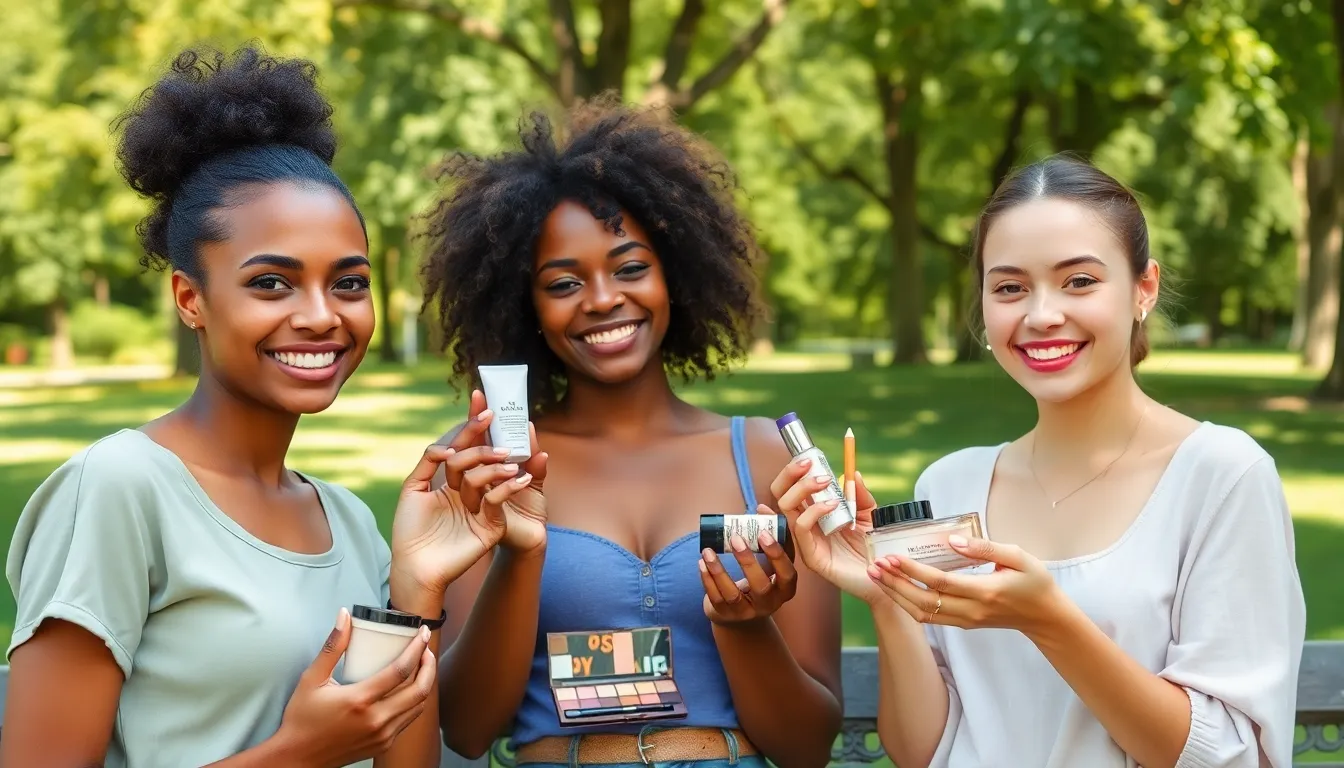In a world where beauty can sometimes feel like a battlefield, cruelty-free brands are the shining knights in eco-friendly armor. They prove that looking fabulous doesn’t have to come at the expense of our furry friends. With an increasing number of consumers demanding ethical choices, these brands are stepping up their game, offering products that are not only kind to animals but also packed with quality ingredients.
Imagine slathering on a moisturizer that makes your skin glow while knowing no bunnies were harmed in the process. It’s like getting the best of both worlds: fabulous skin and a clear conscience. Whether you’re a seasoned vegan or just someone who loves cute animals, cruelty-free beauty brands are here to save the day—and your beauty routine! Let’s dive into the world of compassionate cosmetics and discover why they deserve a spot on your vanity.
Table of Contents
ToggleOverview Of Cruelty-Free Beauty Brands
Cruelty-free beauty brands emphasize ethical practices and seek to eliminate animal testing in their product development. These brands cater to a growing market that values conscientious consumerism. Products with cruelty-free labels signify commitment to animal welfare, appealing to consumers who prioritize ethical considerations in their purchases.
The demand for cruelty-free options has surged. Studies show that nearly 60% of consumers prefer cosmetics not tested on animals. Brands like e.l.f. and Too Faced exemplify this trend by offering vibrant, effective products without compromising ethics. They provide consumers with alternatives that align with their values.
Certifications play a crucial role in identifying cruelty-free brands. The Leaping Bunny and PETA’s Beauty Without Bunnies logos serve as reliable indicators of cruelty-free practices. Understanding these certifications aids consumers in making informed choices in cosmetics. Adopting cruelty-free beauty habits allows individuals to contribute to a more humane industry.
Many cruelty-free brands also focus on sustainability. Eco-friendly packaging and natural ingredients are often key components of their formulations. Brands like Tarte and Fenty Beauty incorporate sustainable practices alongside their cruelty-free pledges. Such initiatives not only enhance product integrity but also attract environmentally conscious consumers.
Cruelty-free beauty brands are transforming the cosmetics industry by prioritizing ethical practices and meeting consumer demand for responsible choices. Engaging with these brands supports both beautification and animal welfare, allowing individuals to express themselves while standing up for ethical principles.
The Importance Of Cruelty-Free Products

Cruelty-free products play a vital role in fostering ethical beauty practices. Brands that prioritize compassion toward animals reflect a growing societal shift toward accountability in the cosmetics industry.
Ethical Considerations
Ethical considerations in beauty products necessitate a commitment to animal welfare. Consumers increasingly reject animal testing, opting for humane alternatives instead. Many cruelty-free brands actively promote transparency in their practices, ensuring that customers understand how products are made. Choosing brands that align with ethical values supports a movement toward empathy in consumer choices. Certifications from third parties, like the Leaping Bunny, provide trust and assurance, making it easier for consumers to make responsible decisions. Prioritizing cruelty-free options fosters a beauty landscape where respect for all living beings flourishes.
Consumer Awareness
Consumer awareness of cruelty-free beauty continues to rise. Nearly 60% of consumers now prefer cosmetics that don’t involve animal testing. The demand for cruelty-free options encourages brands to innovate and develop effective products without compromising ethical standards. Social media plays a significant role in educating the public about these options, amplifying the voices of brands committed to kindness. More individuals seek out cruelty-free certifications to ensure their choices align with their values. This trend indicates a significant shift as conscious consumers increasingly recognize the impact of their purchasing power on animal welfare.
Popular Cruelty-Free Beauty Brands
Cruelty-free beauty brands offer a diverse array of products that meet ethical standards. These brands prioritize animal welfare while delivering effectiveness and quality in their offerings.
Skincare Brands
Brands like Tarte and The Ordinary excel in skincare without causing harm to animals. Tarte focuses on natural ingredients, ensuring their products are both effective and environmentally friendly. The Ordinary offers transparent formulations with high-quality components, appealing to those interested in skincare science. With a growing focus on sustainability, these brands showcase cruelty-free principles, aligning with consumer preferences for ethical and transparent practices.
Makeup Brands
Too Faced and e.l.f. lead the way in cruelty-free makeup, appealing to vibrant beauty enthusiasts. Too Faced combines playful branding with innovative products, like their popular Better Than Sex mascara. e.l.f. delivers affordable, high-quality cosmetics that prove effective without animal testing. Their commitment to cruelty-free practices resonates with a significant portion of conscious consumers, who increasingly demand ethical options in their beauty routines.
Haircare Brands
Haircare brands such as Pureology and Olaplex stand out in the cruelty-free market, focusing on both performance and ethical standards. Pureology emphasizes eco-friendly packaging and sulfate-free formulas, catering to those seeking sustainable options. Olaplex highlights breakthrough technologies that repair damaged hair without compromising on ethical values. By prioritizing cruelty-free practices, these brands successfully attract customers committed to animal welfare while maintaining high performance standards in haircare.
How To Identify Cruelty-Free Products
Identifying cruelty-free products involves understanding specific labels and industry practices. The following criteria help consumers make informed choices.
Certifications To Look For
Certifications play a vital role in identifying cruelty-free products. Look for logos like the Leaping Bunny and PETA’s Beauty Without Bunnies. These certifications indicate a brand does not engage in animal testing. Brands must meet strict criteria to earn these labels, offering transparency in their practices. Certifications confirm that consumer choices align with ethical values. Many major brands, including e.l.f. and Too Faced, proudly display these logos, enhancing consumer trust in their products.
Common Misconceptions
Misconceptions often cloud the understanding of cruelty-free labels. Some consumers believe that all vegan products are cruelty-free; however, that isn’t always the case. Vegan products exclude animal ingredients but may still undergo animal testing. Additionally, another misconception is that products labeled as “not tested on animals” guarantee cruelty-free status. This claim can sometimes lack the rigor of certification labels. Understanding these distinctions helps consumers make better decisions and avoid misleading claims.
The growing popularity of cruelty-free beauty brands signifies a pivotal change in consumer values. As individuals increasingly seek products that reflect their ethical beliefs, these brands rise to meet the demand for compassionate cosmetics.
By prioritizing animal welfare and sustainability, they not only enhance beauty routines but also contribute to a more humane industry. With the right certifications and transparency in practices, consumers can confidently choose products that align with their values.
As this movement continues to gain momentum, it’s clear that cruelty-free beauty is more than a trend; it’s a transformative approach to cosmetics that empowers consumers to make a positive impact.





